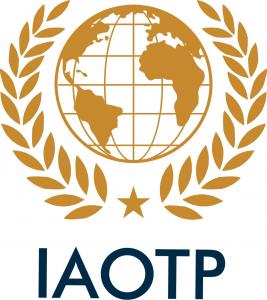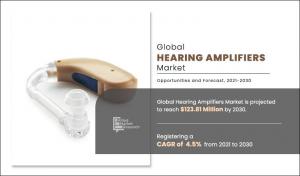Hearing amplifiers market was valued at $80.66 million in 2020, and is projected to reach $123.81 million by 2030, registering a CAGR of 4.5% from 2021 to 2030.
— Allied Market Research
WILMINGTON, DELAWARE, UNITED STATES, February 16, 2024 /EINPresswire.com/ — Hearing loss is the loss of hearing in one or both ears, ranging from mild to profound. There are many causes, and it can affect anyone at any age, but it’s most common among people older than 60 years age.
The major causes for hearing loss are age-related hearing loss, exposure to excessive noise, or family history of genetic disorder. There are various solutions for hearing loss, including hearing amplifiers and aids. The hearing amplifiers is categorized into product, type, distribution channel, and region. Hearing loss is also associated with overuse of ototoxic drugs, trauma or injury to the head, Meniere’s disease, otosclerosis or autoimmune disease and acoustic neuroma.
📚 𝐃𝐨𝐰𝐧𝐥𝐨𝐚𝐝 𝐒𝐚𝐦𝐩𝐥𝐞 𝐂𝐨𝐩𝐲 𝐨𝐟 𝐑𝐞𝐩𝐨𝐫𝐭: https://www.alliedmarketresearch.com/request-sample/A10990
Hearing loss has a major impact on the emotional, psychological, and social life; patients suffering from hearing loss get fewer educational and job opportunities due to impaired communication, social withdrawal due to reduced access to services and difficulties communicating with others, and emotional problems caused by a drop in self-esteem and confidence. This propels the development of effective solutions for the treatment of the same and advances in the hearing amplifiers. According to the National Institute on Deafness and other Communication Diseases, 15% of American adults suffer from hearing amplifiers. This also indicates that approximately 37.5 million of the U.S. residents have some trouble hearing.
Some of the other factors responsible for substantial market growth include increasing prevalence of hearing loss disorders globally, rising geriatric population globally, advances in the technology of hearing amplifiers and favorable regulatory scenario for the sales of the global hearing amplifiers market.
𝐏𝐫𝐨𝐜𝐮𝐫𝐞 𝐂𝐨𝐦𝐩𝐥𝐞𝐭𝐞 𝐑𝐞𝐬𝐞𝐚𝐫𝐜𝐡 𝐑𝐞𝐩𝐨𝐫𝐭 𝐍𝐨𝐰 : https://www.alliedmarketresearch.com/hearing-amplifiers-market/purchase-options
Factors such as social stigma associated with wearing hearing amplifiers due to which people are reluctant to wear hearing amplifiers restrict the market growth to a certain extent.
Moreover, growth in healthcare expenditures in the developing economies and entry of new players in the emerging economies offers lucrative opportunities for the hearing amplifiers market.
This pandemic of coronavirus has negatively impacted the global hearing amplifiers market. In the emergency of COVID-19, people are defending themselves by social distancing, wearing masks and washing their hands regularly. According to a new study conducted by Hearing Health Foundation, more than 87% of the people who have hearing disorders are facing difficulty in communication. These factors are creating more difficulties for people with hearing loss, which is predicted to restrain the demand for hearing amplifiers during the pandemic period. Moreover, due to the COVID-19 outbreak, the elective procedures outside the U.S. were also postponed in several countries. Covid-19 negatively impacted the hearing amplifiers market as well. The pandemic creating barriers for hospital patients who are facing hearing disorders. Use of mask during the pandemic has increased, which thereafter made it harder for people who rely on lip-reading and facial expressions to communicate. Due to social distancing, many hospitals have restricted interpreters and visitors, and they are instead offering patients’ video conferencing with hearing aids to overcome the limitations of the market growth.
🎯 𝐄𝐧𝐪𝐮𝐢𝐫𝐞 𝐁𝐞𝐟𝐨𝐫𝐞 𝐁𝐮𝐲𝐢𝐧𝐠 : https://www.alliedmarketresearch.com/purchase-enquiry/A10990
Rising geriatric population, increasing incidences of hearing impairments creating a patient pool, availability of affordable hearing amplifiers are the factors contributing to the market growth. The advancements in the medical field and reduction in the cost of treatments along with use of various customizable hearing amplifier devices as per consumer needs would further surge the demand for these devices in the market.
Adults in age group of 70 years and above that is 30 million Americans have reported for significant hearing loss. Recent customizations in hearing amplifiers owing to elder population consumer base improve hearing and makes sound louder and more audible by reducing disturbing external voices. WHO stated that approximately 466 million people in 2018, have hearing loss globally and majority of these people fall in the age group of 50 years and above. Therefore, increasing geriatric population would contribute to rise in the market for hearing amplifiers. Presbycusis, or age-related hearing loss, comes on gradually as a person gets older. It seems to run in families and may occur because of changes in the inner ear and auditory nerve. Presbycusis makes it hard for a person to tolerate loud sounds or to hear what others are saying. Age-related hearing loss usually occurs in both ears, affecting them equally. The loss is gradual, so someone with presbycusis may not realize that he or she has lost some of his or her ability to hear.
𝐓𝐡𝐞𝐬𝐞 𝐟𝐚𝐜𝐭𝐨𝐫𝐬 𝐚𝐫𝐞 𝐞𝐱𝐩𝐞𝐜𝐭𝐞𝐝 𝐭𝐨 𝐩𝐫𝐨𝐩𝐞𝐥 𝐭𝐡𝐞 𝐠𝐫𝐨𝐰𝐭𝐡 𝐨𝐟 𝐭𝐡𝐞 𝐡𝐞𝐚𝐫𝐢𝐧𝐠 𝐚𝐦𝐩𝐥𝐢𝐟𝐢𝐞𝐫𝐬 𝐦𝐚𝐫𝐤𝐞𝐭.
The hearing amplifiers market is segmented on the basis of product, type, distribution channel, and region. By product, the market is divided into behind-the-ear and in-the-ear. On the basis of type, it is classified into analog hearing aids and digital hearing aids. Further, by distribution channel, it is classified into hospital pharmacies, online pharmacies, and others. By region, the market is analyzed across North America, Europe, Asia-Pacific, and LAMEA.
By product, the behind-the-ear segment generated the highest revenue in 2020, accounting for 52.06% of the total market. This is attributed to the rising popularity, due to the advanced features of behind-the-ear hearing amplifiers and the continuous advances in the product.
By type, the analog hearing devices segment generated the highest revenue in 2020 and is anticipated to continue this trend throughout the forecast period. This is attributed to rising awareness, increasing geriatric population, and awareness of the availability of treatment options.
By distribution channel, the hospital pharmacies segment generated the highest revenue in 2020 accounting for 59.35% of the total share of the market and is anticipated to continue this trend throughout the forecast period. This is attributed to the favorable healthcare reimbursement for hearing implantation and the increased penetration of hearing amplifiers.
North America is expected to dominate the overall market throughout the forecast period. This is attributed to growing geriatric population and increasing cases of deafness occurrence is contributing to the growth of the market in the region.
𝐓𝐡𝐞 𝐤𝐞𝐲 𝐩𝐥𝐚𝐲𝐞𝐫𝐬 𝐢𝐧 𝐭𝐡𝐢𝐬 𝐦𝐚𝐫𝐤𝐞𝐭
Beurer GmbH
Etymotic Research, Inc.
Innerscope Hearing Technologies, Inc.
IntriCon Corporation
Sound World Solutions
Otofonix Hearing Solutions
MD Hearing Aid
Cochlear Limited
Eargo, Inc.
Starkey Hearing Technologies.
𝐊𝐞𝐲 𝐅𝐢𝐧𝐝𝐢𝐧𝐠𝐬 𝐎𝐟 𝐓𝐡𝐞 𝐒𝐭𝐮𝐝𝐲
✔️ By product, the behind-the-ear segment held largest share in the global market in 2020.
✔️ By type, the analog hearing devices segment held the largest market share in 2020 and is expected to remain dominant throughout the forecast period.
✔️ By distribution channel, the hospital pharmacies segment dominates the global market in 2020 and is anticipated to continue this trend during the forecast period.
✔️ By region, North America is expected to experience highest market share, and is expected to register revenue of $38.67 million till 2030.
David Correa
Allied Market Research
+1 5038946022
email us here
Visit us on social media:
Facebook
Twitter
LinkedIn
![]()
Article originally published on www.einpresswire.com as Hearing Amplifiers Market Expected to reach $123.81 million by 2030 | Boom in Near Future













